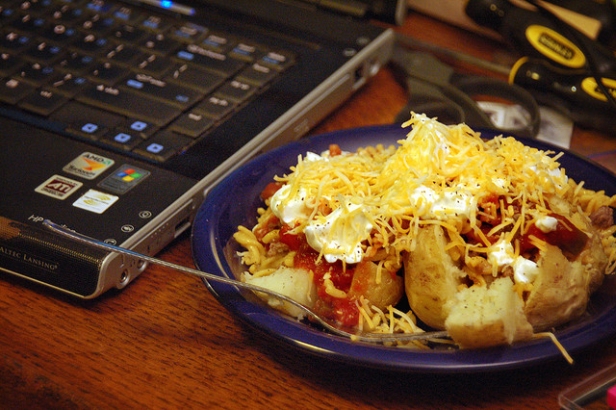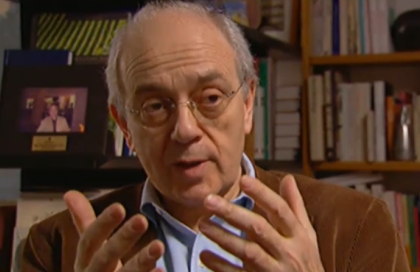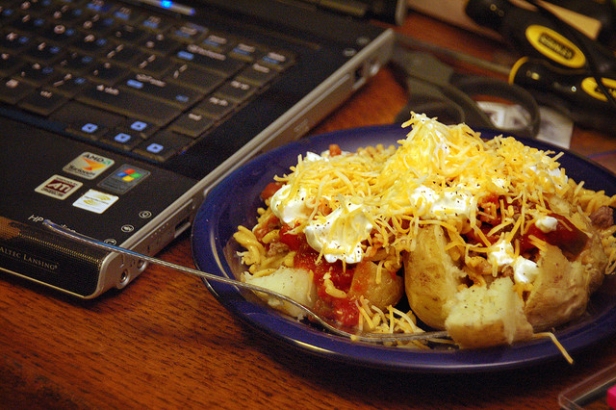 Dinner as usual?Photo: Matt DeTurck
Dinner as usual?Photo: Matt DeTurck
Put down that sandwich. Or if you’re not eating right now, tell the truth: How many crumbs are lodged in your keyboard from previous meals wolfed in front of your monitor?
It’s OK. You’re not alone in eating alone — at least in America. It’s what most of us do: in front of our computers and televisions, or in our cars. But as the preëminent French food sociologist Claude Fischler explained in the fifth lecture of the University of Washington’s food and environment series recently, we represent one extreme end of the social-eating spectrum, and the French another — and in getting there, we’ve also strayed quite far from the ways that humans have consumed food for thousands of years.
The simple act of eating involves more than just you and your food — society is also present, in the customs, in the place, and in your companions (or lack thereof), Fischler told the audience.
 Claude Fischler, international man of food mysteryHistorically, humans have eaten together commensally, habitually and ritually, either as equals or as part of a hierarchy. Think Da Vinci’s painting of the Last Supper, with its specific depiction of social order and the ritual breaking of bread and sharing of wine. Commensality is sometimes extremely formal, such as at a Japanese corporate lunch, but just as often is informal, as when an Ethiopian family dips into a central bowl of meats and sauces.
Claude Fischler, international man of food mysteryHistorically, humans have eaten together commensally, habitually and ritually, either as equals or as part of a hierarchy. Think Da Vinci’s painting of the Last Supper, with its specific depiction of social order and the ritual breaking of bread and sharing of wine. Commensality is sometimes extremely formal, such as at a Japanese corporate lunch, but just as often is informal, as when an Ethiopian family dips into a central bowl of meats and sauces.
It’s been a useful concept for humanity to have around, serving historical functions such as:
- allocating each person’s share of food
- including or excluding people according to social organization
- showing the pecking order
- structuring time (before lunch versus after dinner)
- forming identity (the lost art of teaching kids to behave while eating)
- weaving social fabric together (such as at wedding or funeral feasts)
Eating alone, on the other hand, has typically been stigmatized and treated suspiciously. What did the person do to be excluded from or punished by his social group? Was she taking more than her fair share of the food? Fischler described the act of eating alone as “negat[ing] humanity” for us social creatures.
From slow food to slow eaters
“In the Western world food has been turned into an exclusively private good,” Fischler said. One that we “have to make choices about, preferably rationally, and we don’t live well with that idea.” Or eat well, apparently.
Fischler and his colleagues surveyed 7,000 people from the United States and five European nations (France, Italy, Switzerland, Germany, and England) about their attitudes toward food and health. They found a spectrum of attitudes, with the U.S. occupying one extreme end and France, the other.
Here in the good ol’ U.S. of A, our national identity as disparate, atomized individuals is reflected in how we see our food: nothing more than a sum of individual nutrients that can be customized to fit the health needs and tastes of the individual. Americans value choice in their diets above almost all else. They want to build a diet especially for their bodies and what they choose to put in their bodies is always their choice. The American obsession with choice stood out markedly from the other five countries surveyed, and is the case in other studies as well.
On the other hand, the French made clear that “not all eating is eating.” Eating “requires a certain configuration of time, space, and people” to constitute a meal. For example, a Frenchwoman, Fischler recounted, would tell researchers that she hadn’t eaten all day but then state plainly that she bought and consumed a pastry from a baker’s stand. The French also honed in on food’s quality and culinary identity: How does it taste? Where does it come from? How fresh is it?
 It’s not just what you’re eating, it’s who you’re eating. Er, with! Who you’re eating with.Photo: More Good FoundationAlong these same lines, the English-speaking countries in the study (U.S. and Britain) distinguished themselves from the continental European nations (France, Switzerland, Germany, and Italy) by describing health as the main purpose of eating. For the others, health is a secondary benefit; social pleasures and the joy of life dominate continental Europeans’ discussions about eating. As one Italian put it, “to eat good fish and drink good wine” with friends is the true meaning of eating well. That sounds convivial, even commensal. It also sounds worlds away from the anxiety revealed by middle-aged American women weighing the protein and carbohydrates necessary to eat well.
It’s not just what you’re eating, it’s who you’re eating. Er, with! Who you’re eating with.Photo: More Good FoundationAlong these same lines, the English-speaking countries in the study (U.S. and Britain) distinguished themselves from the continental European nations (France, Switzerland, Germany, and Italy) by describing health as the main purpose of eating. For the others, health is a secondary benefit; social pleasures and the joy of life dominate continental Europeans’ discussions about eating. As one Italian put it, “to eat good fish and drink good wine” with friends is the true meaning of eating well. That sounds convivial, even commensal. It also sounds worlds away from the anxiety revealed by middle-aged American women weighing the protein and carbohydrates necessary to eat well.
It’s not surprising that attitudes toward eating differ among countries and cultures. But what are the consequences of those differences?
Food portions are significantly bigger in the U.S. than in France. Yet North Americans spend less than an hour each day eating what’s on their hefty plates, while the French spend more than two hours each day enjoying “food experiences.” France’s obesity rate weighs in much lower than America’s and even other European nations’. American women spend more time multi-tasking while eating and are less likely to remember everything (or time) they ate than do French women. (“If you’re eating constantly, it’s difficult to remember,” Fischler cracked.)
Does this all add up to the mysterious “French Paradox“? Fischler doesn’t think it’s much of a mystery.
“What happened with food in the West is that food became disenchanted,” Fischler said. When we grab food without thinking, without ritual, there is a loss of meaning, he later went on. When food is commodified and processed, it retreats into a black box. “We are what we eat and if we don’t know what we eat …” You can see where he’s going with this.
The value of commensality could, however, be poised for a comeback in this portly, peaked part of the world. Michael Pollan e
xplores the role of culture as a guide to eating in several of his books, when he challenges science as “the only source of authority we have on matters having to do with food in our bodies,” and his most recent feature for the Times magazine was about “a 36-hour dinner party.” The expansion of community kitchens and the re-prioritization of the family dinner offer other optimistic examples at kitchen tables around the country.
Fortunately for folks new to the various facets of the sustainable food movement, the learning curve is pretty gentle and stacked with flavorful rewards. I’ve come to realize, bite by bite, the succulent benefits of eating more fresh vegetables and fruits, which are missing nothing but the synthetic chemicals; of forming a knowledge of — nay! a relationship with — the friendly local people growing my food and brewing my beverages; and now, the deeper joys of more regularly feasting with friends.
All of this can threaten to overpower us imperfect humans at times — What if I eat fast food just this once? Will others judge me? — but another great aspect is that we get a second chance at every meal. Just as I went straight home from Fischler’s lecture to eat a late dinner by myself, I felt a rush of redemption this past weekend when I shared a sumptuous meal with my roommate and my neighbor — which blossomed into over an hour of grace, laughter, and taste. Eat it, French Paradox.



